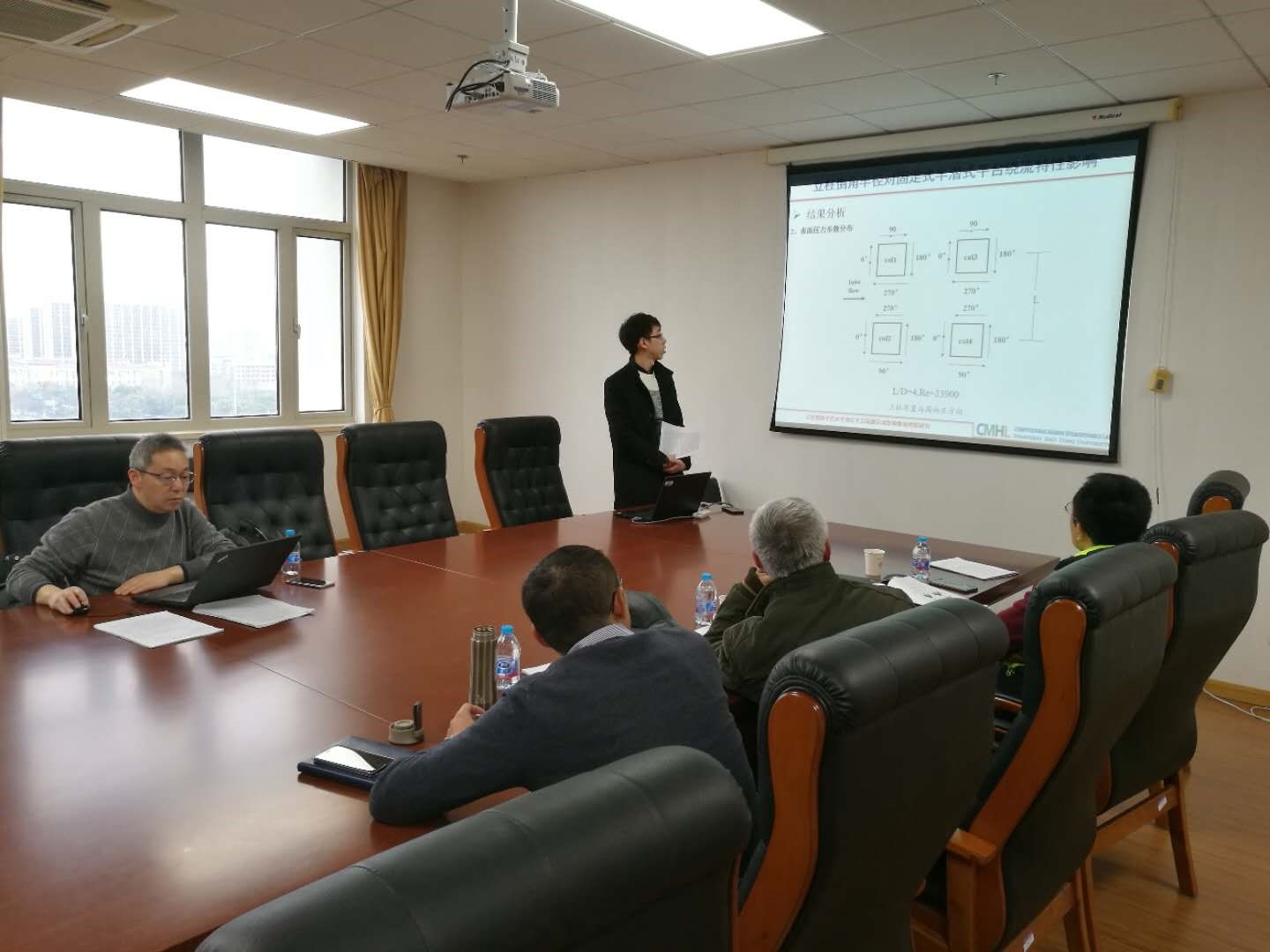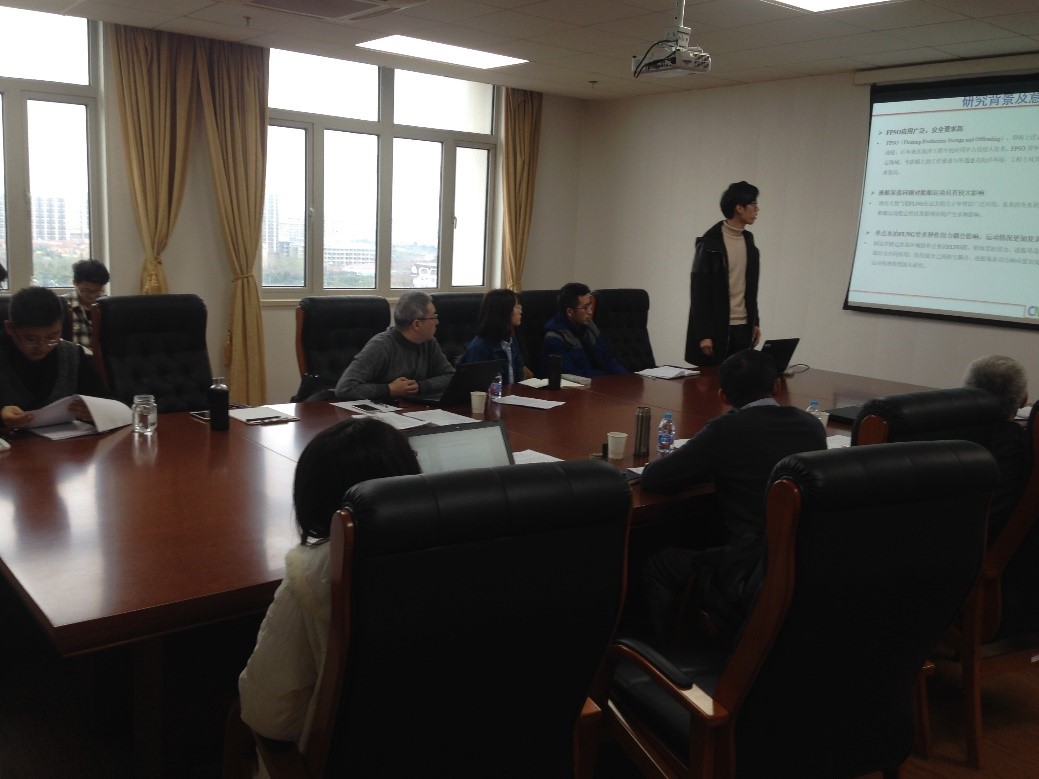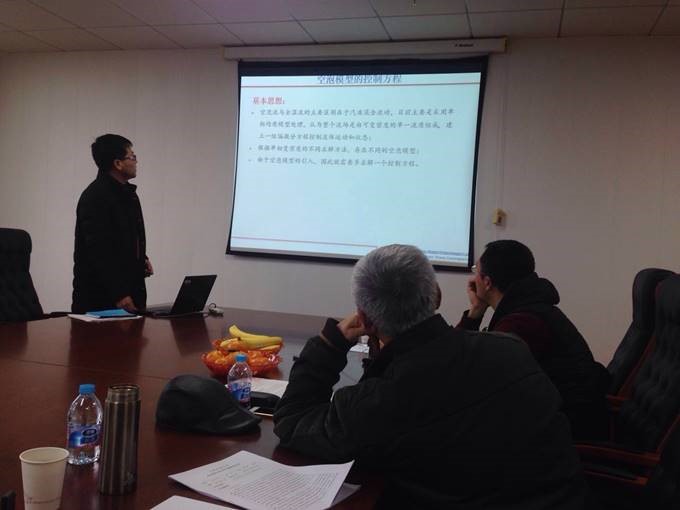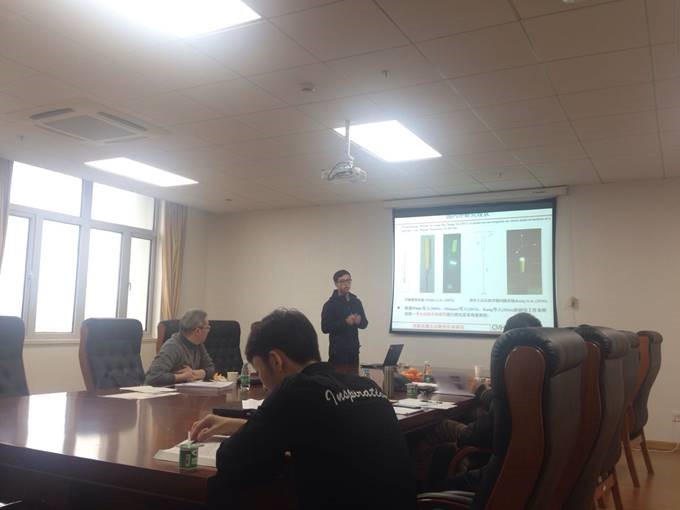|
|
The Thesis Proposal Presentations for Master’s Students of Grade 2016 has Successful Coucluded
Editor by:【admin】 On:【2017-12-14】
On December 14, 2017, 14 master students of grade 2016: Li Siming, Wang Di, Li Qi, Tian Xin, Chen Taiwen, Qi Xiaozhou, Song Jiaqi, Chen Kaijie, Duan Xinze, Wang Zhe, Wu Di, Xu Lurong, Xie Kangdi and Sun Chenguang conducted thesis proposal presentations for the master's students in Mulan Shipbuilding Building, Room A1006. The experts responsible for the defense are Professor Zou Zaojian, Research Fellow Liang Fuyou, Associate Professor Zhao Min, and Professor Wan Decheng. Prof. Zou was the head of the assessment team and first made clear to everyone the time of presentations and related regulations. Then, fourteen students reported in turn.
The topic of Li Siming's thesis is: “numerical simulation study of influence of the chamfered radius of column on the vortex-induced motion of a deep-draft semi-submersible platform.” The research background of studying the effect of the chamfer radius of the column on the vortex-induced motion of the semi-submersible platform is mainly described. Also, the research status and main research contents of this direction are introduced. In terms of the work carried out, the specific influence of column chamfer radius on the the flow around the fixed semi-submersible platform and the free decay test of different column chamfer radius semi-submersible platforms are introduced. The teachers expressed their affirmation of his existing work, and at the same time suggested that the progress of the plan and the working ideas should be more clearly stated in the thesis proposal report.
The topic of Wang Di’s thesis is:”Research on hydrodynamic performance of point-suction wave power plant.” Firstly, the development status of wave power generation devices is introduced, and the advantages of point-suction wave power generation devices are summarized. Then he introduced the main research methods and demonstrated the advantages of the CFD method. Also, the main work content was summarized, and the main problems of wave energy power generation devices were the efficiency and stability. Finally, the current work progress and the next work plan are introduced. Teachers believe that the relationship between wave power generation devices and engineering applications should be considered, and the effect of three-dimensional effects of power generation devices on wave transformation can be studied.

The subject of Li Qi's thesis is: “The single-point mooring FLNG tank sloshing coupled motion in waves based on the full-field CFD method.” First, Li Qi studied the research background and research status. In his work, the hydrodynamic performances of single point mooring FLNG model in wave field are studied. The effects of liquid filling rate, wave frequency, and wave height on the sloshing phenomenon of the tank were mainly considered. The next step, he decides to calculate the coupled motion of the single point mooring FLNG with a tank. The review experts confirmed the existing work results, and proposed that the water filling rate can be changed to the liquid filling rate. The research on the anchor chain can be conducted and the dynamic LPP method can be used to simulate the anchor chain.

The topic of Tian Xin's thesis is: “The GPU-accelerated MPS method numerically simulates the problem of three-dimensional large-scale tank sloshing.” The application of GPU acceleration technology is introduced. The GPU acceleration solver was verified using the dam break standard problem, and the GPU solver was used to study large-scale tank sloshing and slamming, and the coupled effect of three-dimensional wave and tank sloshing was studied. The results of the verification of the solver using the dam-breaking problem so far are described. The solver has been calculated accurately, and the efficiency has been greatly improved. The teacher thinks that the current researcha bout convergence test is not detailed enough, and it should be added new calculation examples to strengthen the verification. At the same time, the relationship between the acceleration effect and the number of particles can be further explored.
The paper titled by Chen Taiwen’s thesis is: Uncertain ship optimization method based on OPTShip-SJTU. During this report, he introduced the problem of ship optimization with uncertainties and its methods. He also elaborated the importance of considering uncertainty in the shipbuilding optimization process, and used C++ and matlab programming to realize the optimization method of interval number and robustness. Contrasting and analysing the shape change and hydrodynamic performance expectations and standard deviations of the parent ship and the optimised ship demonstrates the effectiveness of the uncertainty optimization. The next step, he will consider other uncertainties or even the coupling of multiple uncertain parameters to optimize the ship's shape. After listening to his report, the teachers proposed that there is no experimental verification of the current shipbuilding optimization results, and he should conduct experiments to verify the effectiveness of the optimization results.Since only Fr currently considers as an uncertain factor, the design variables uncertainty should be considered together in the future.
The essay of the Qi Xiaozhou's thesis is: “The numerical optimization based on the NURBS hull profile.” Firstly, the widely used ship shape transformation method is briefly introduced. The free deformation method, radial basis function method and NURBS surface theory are mainly introduced. He shows an example of directly generating hull bulbous bow based on moving NURBS control points and combining FFD method and RBF to realize hull deformation method. And he also introduced an example of the optimization of a container ship. The next step is to continue to refine the NURBS-based ship conversion method, including node insertion and refinement, local encryption of NURBS control points, and generation of hull grids based on NURBS. The teachers gave the following suggestions: For node encryption, how to achieve local encryption through control. For hull deformation, how to meet the hull displacement and other constraints.

The topic of Song Jiaqi's thesis is: “The deformity wave simulation based on the combination of high-order spectrum method and CFD.” The use of higher-order spectrum methods to simulate the generation of malformed waves is described. He introduced, in the current stage, the HOS-ocean has been used to simulate a large-scale long-term wave field, generate and analyze deformed waves, and simulate the generation of three-dimensional focus waves by phase adjustment. Finally, the method of how to realize the combination of HOS and CFD and use the model to analyze the implementation of the wave load of deformed waves on the object and the future work plan are summarized. The teachers believe that the purpose of the future work must be more explicit. In addition, it is necessary to make clearly that using the CFD method in the study of the interaction between waves and objects in which aspects are more advantageous than the potential flow method.
The topic of Chen Kaijie’s thesis is: numerical simulation of the air bubble flow of wings and propellers based on OpenFOAM. He introduced the research status at home and abroad from the aspects of experiments and numerical simulations, and introduced the theory of the bubble flow, and mainly introduced the classification and derivation of the relevant control equations and the vacuolar model. The defense teachers proposed that a cavitation simulation can be performed on a wing with a limited aspect ratio, so that it can be compared with the results obtained by an infinite aspect ratio model; in addition, the comparison between simulation and experimentation may not guarantee a complete match of the operating conditions. Therefore, it is necessary to further familiarize with the configuration of experiments, and strive to improve the accuracy of simulation results on the basis of clarifying and analyzing the differences between penetration experiments and numerical simulation work conditions.

The paper titled by Duan Xinze's thesis is: wind field wake control and layout optimization based on actuating line model. Firstly, the research background and significance of the turbines based on the actuating line model are introduced, and the effects of the wake interference between multiple turbines in a wind farm based on the actuating line model and CFD technology are briefly introduced, and also the affect of the aerodynamic performance of the turbines and the development of the turbines wake caused by adjusting the arrangement form and the yaw angle of the upstream turbines was introduced. The next step is to change the layout of the wind turbines in the wind field and change the wake impact range of the upstream wind turbines to reduce the wake disturbances between the wind turbines, so as to achieve the purpose of improving the overall power generation efficiency of the wind farm, and to analyse the mechanism of interaction wakes between the wind turbines and optimization of wind field layout. The teachers think that it is necessary to describe the operating conditions of the wind field in more detail, analyze the wake characteristics of the wind field in more detail, and pay attention to the use of professional vocabulary.
The topic of Wang Zhe's thesis is: “Numerical study of vortex-induced vibration of top tensioned riser under the influence of heave motion of the platform.” He first explained the research question. For the top tensioned riser, the influence of the heave motion of the platform can be converted into axial tension that changes with time. As for this issue, the main research status at home and abroad was summarized. After that, he introduced the work plan and the completed work. The influence of the heave motion of the platform was analyzed, the influence mechanism was explained, and the parameters were analyzed. Finally, the multi-modal vibration characteristics under the influence of platform heave motion were discussed. The teachers think that the work plan should be more clear, and at the same time, the completed work should be summed up in a timely manner.
The topic of Wu Di's thesis is: “Application and improvement of RANS/LES hybrid method in simulating large separation flow problems.” The main research contents are as follows: The DRES model and the SAS model are used to simulate the flow around a cylinder of the Subcritical Reynolds Number and the results were compared with the experimental data. The influence of Lvk limiters with different coefficients on the SST-SAS model is discussed. At the same time, he tried to introduce the dynamic model in the LES model into the SST-DES model. After that, the main task is to increase large separation flow examples such as the wing flow to better analyze the simulation performance of the RANS/LES hybrid model. At the same time, an example analysis is performed on the improved DDES model of SAS principle and the DES model with power mode. The teachers suggested adding some large separation flow examples instead of being limited to cylindrical flow。
The topic of Xu Lurong’s thesis is: “Numerical simulation and analysis of the energy-saving characteristics of the Propeller Boss Cap Fins. The main work is divided into three parts: the analysis of the energy-saving mechanism of the Propeller Boss Cap Fins, the influence of design parameters on the energy efficiency of the Propeller Boss Cap Fins, and the scale effect of the Propeller Boss Cap Fins. At present, the research on the energy-saving mechanism of Propeller Boss Cap Fins has been completed. The teachers and instructors have affirmed the work that has been completed, and also put forward some suggestions, for example, the paper should focus on a more in-depth analysis of the Propeller Boss Cap Fins energy-saving mechanism./span>
The topic of Xie Kangdi's thesis is: “Numerical simulation of the vortex-induced rotation of a floating tank. Firstly, the research background of FSR system containing buoyancy tanks and buoyancy tanks is introduced. Afterwards, the significance of the research was analyzed from two aspects of industrial application and academic research. Then the innovation and research content of the topic were further introduced. Then he introduced the SST-DES turbulence model and the overlapping grid method used in the project. Then work already done were introduced from three aspects: the numerical simulation of the vortex-induced rotation of three-dimensional floating tank, the post-processing of the three-dimensional floating tank, and the preliminary guesswork of the vortex-induced rotation mechanism. Finally, the further work regrading the floating tank vortex-induced rotation was introduced. After listening to the report, the teachers thought that the research object was cylindrical, so the name “floating tank” should be changed to “floating cylinder” to be more appropriate in the research process of exploring the rotation mechanism of the cylinder. In addition, the research on the rotation of the square column could be considered.

The paper titled by Sun Chenguang’s thesis is: Numerical simulation and analysis of ship stopping based on overlapping grids. The preparatory work explained the research significance of the subject by explaining the background of the topic and investigating the research status at home and abroad. The numerical simulation of the asternway and stopping operation of the KVLCC has been carried out. The preliminary calculation results have been obtained and compared with the experimental results to verify the accuracy of the numerical simulation. It shows that the further work will carry out numerical simulation of the asternway and stopping operation of the ship model under different working conditions and analyze the flow mechanism of the phenomenon. The experts proposed that the entire process of turning the propeller from forward to reverse can be considered

All fourteen students passed the thesis proposal presentations for master’s students. They demonstrated their rich work since they entered the school and won the unanimous approval of the evaluation teachers. At the same time, both the evaluation experts and the instructors put forward some very instructive opinions, which laid a solid foundation for the students to focus on their work, set the research priorities, and carry out further work. Here, I would like to express my congratulations and thank all the teachers for their guidance and assistance.
|
|